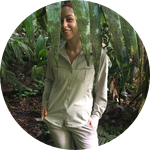Project Results
Genetic and phenotypic evidence of a contact zone between divergent colour morphs of the iconic red‐eyed treefrog
Maria Akopyan, Zachariah Gompert, Karina Klonoski, Andres Vega, Kristine Kaiser, Rachel Mackelprang, Erica Bree Rosenblum, Jeanne M. Robertson
About This Project
The red-eyed treefrog exhibits variation among populations, including differences in color pattern, body size and advertisement calls. Genetic analyses show that populations in Costa Rica and Panama have differentiated despite spatial overlap, indicating that evolutionary forces are at work. Understanding the extent of genomic divergence among populations that remain in contact can reveal the relative strength of evolutionary forces.
Ask the Scientists
Join The DiscussionWhat is the context of this research?
Many studies examine reproductive isolation inclosely related or hybridizing species to understand the process by which new species evolve. However, identifying the genetic signature of reproductive isolation requires examining organisms with varying degrees of relatedness.
Admixed populations that have accumulated changes resulting from barriers that prevent genetic exchange offer a unique view by elucidating the evolution of reproductive isolation while still in its earlier stages.
The Neotropical red-eyed treefrog exhibits substantial phenotypic variation among regions and thus is an ideal system for studying early-stage population diversification.
What is the significance of this project?
Understanding the extent of genomic divergence among populations that remain in contact, as well as populations across geographic barriers, can reveal the relative strength of evolutionary forces that mediate lineage diversification.
These forces ultimately influence whether populations will remain distinct and continue to accumulate differences. There is tremendous potential for the application of genomic technologies for understanding diversification at the molecular level. This research is well suited for public outreach. By studying divergence in a well-known charismatic species, such as the red-eyed treefrog, my research can be used to create media that will attract attention and inform the public of the processes of evolution and the importance of understanding biodiversity.What are the goals of the project?
I will analyze genetic data from newly sampled populations along with 120 previously collected samples from 22 populations throughout Costa Rica and Panama. I will use ddRADseq, an efficient and cost-effective sequencing technique suitable for non-model organisms.
Budget
In order for this project to be a success, I need to travel to Panama to collect genetic samples from four populations along the Caribbean coast. These populations exhibit the highest level of variation relative to all other Central American populations. Exploring these hard-to-sample areas is crucial for understanding the evolutionary history of this region. Your generous donation will cover travel costs to Panama and allow for a 3-week field season. I will be the first to collect genetic data from the northern regions of provinces: Comarca Ngobe-Buglé, Veraguas, Coclé, and Colón. Traveling to and from these sites requires a rental car and sampling requires travel by horseback, foot, and canoe. I will consult local field guides to assist in locating red-eyed treefrog populations. We will collect non-lethal DNA samples from frogs found in lowland swamps and return individuals to where they were found. All funds raised will go toward transportation, field supplies, and lodging.
Meet the Team
Team Bio
My fascination with biology was ignited when I began to approach concepts in the context of evolution. I chose to study biology because I genuinely found every subject, from molecular biology to ecology, interesting. That interest quickly grew into passion when I realized that evolutionary theory could disambiguate and explain the interrelatedness of all aspects of this field. I am therefore eager to study the factors that govern evolution. My goal as an aspiring biologist is to examine the forces that exert selective pressures on populations, and to understand how that leads to adaptation and diversification.
I plan to pursue a PhD after earning a Master's from California State University, Northridge. Having been inspired by my professors and mentors, I hope to ultimately apply my knowledge towards educating future scientists.
Project Backers
- 84Backers
- 105%Funded
- $5,251Total Donations
- $47.78Average Donation
